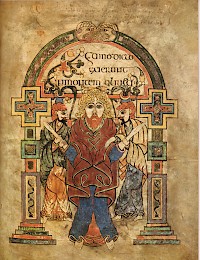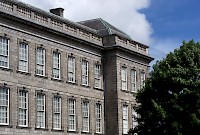Unusual witness of war: The Book of Kells
History isn’t often told by human witnesses, but by other ‘survivors.’ Think for instance of archaeological finds like the remains of buildings, pots and other artefacts. But sometimes, the story of (medieval) warfare can be told through some unusual and unexpected witnesses. One of them is the Irish Book of Kells.

Photo: Public Domain.
Okay, so the Book of Kells is a medieval manuscript and thus a piece of writing. But it isn’t just the writing itself that makes it special. This Irish manuscript, containing the four Gospels, is illuminated with organic Celtic ornaments and animals both extant and mythical. Every single illumination is, at first sight, an amazing and richly decorated picture. But when you look more closely, you’ll find the first words of the first chapter hidden behind the images. And beyond the words and pictures, this manuscript tells us a completely different tale: it is one of the survivors of the Viking raids on the monastery of Iona in 806.
The book was named after the Irish village of Kells. However, writing presumably started in the monastery of Iona which was founded in 561 by the Irish saint Column Cille. According to records, the monastery was raided by Vikings in 806, leaving 68 members of the community dead. The book was saved by some monks who fled to safer grounds, taking their Gospels with them to Kells. Unfortunately, it is uncertain if the book was already finished in Iona or it was finished later in Kells, and due to a lack of sources this question may never be answered making the exact origin of the book a mystery.

Photo: User ‘Barcex’ via WikiMedia Commons
What we do know is that the books was kept in Kells during the whole Middle Ages. According to the Annals of Ulster, it was already named as ‘the chief treasure of the Western world.’ In the 11th and 12th century, the blank pages in the book were used to add recordings of property transactions of the monastery of Kells. The relics of Column Cille were added in 1090. In 1653, the book was sent to Dublin by the governor of Kells. It was taken apart and bound into four volumes in 1953 and nowadays two of these are on display in the library of Trinity College, Dublin. One displays a page with major illuminations, and the other a page with text.
Today, the Book of Kells is one of the most famous medieval Celtic works of art which doesn’t only contain the life of Jesus Christ and the famous Celtic decorations the Irish were known for. It is an unexpected and unusual witness of the Viking raids which was worth saving.
